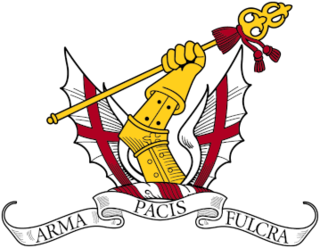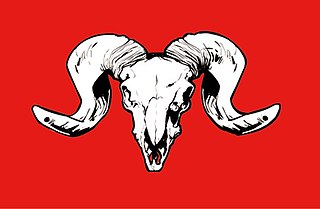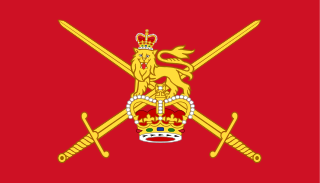
The Royal Regiment of Artillery, commonly referred to as the Royal Artillery (RA) and colloquially known as "The Gunners", is one of two regiments that make up the artillery arm of the British Army. The Royal Regiment of Artillery comprises thirteen Regular Army regiments, the King's Troop Royal Horse Artillery and five Army Reserve regiments.

The Honourable Artillery Company (HAC) is a reserve regiment in the British Army. Incorporated by royal charter in 1537 by King Henry VIII, it is the oldest regiment in the British Army and is considered the second-oldest military unit in the world. Today, it is also a charity whose purpose is to attend to the "better defence of the realm", primarily through supporting the HAC regiment and a detachment of City of London Special Constabulary. The word artillery in this context dates from a time when it meant small projectiles, such as arrows.

The Royal Gibraltar Regiment is the home defence unit, part of British Forces Gibraltar for the British overseas territory of Gibraltar. It was formed in 1958 from the Gibraltar Defence Force as an infantry unit, with an integrated artillery troop. The regiment is included in the British Army as a defence engagement force. In 1999, the regiment was granted the Royal title. The regiment recruits from Gibraltar, the United Kingdom, Republic of Ireland and the Commonwealth.

104 Regiment Royal Artillery is part of the British Army Reserve and has sub-units throughout Wales and the West Midlands of England. It is equipped with the 105mm Light Gun.

105th Regiment Royal Artillery is part of the Army Reserve and has sub-units throughout Scotland and Northern Ireland. It is currently equipped with the L118 Light Gun.

The Sandfontein Artillery Regiment is a reserve artillery regiment of the South African Army.
206 (Ulster) Battery Royal Artillery is an Army Reserve sub-unit, part of the 105th Regiment Royal Artillery. The battery is spread between two locations, Newtownards and Coleraine.

The Nelson Mandela Artillery Regiment is a reserve artillery regiment of the South African Army and part of the South African Army Artillery Formation.
The 8th (Belfast) Heavy Anti-Aircraft Regiment, Royal Artillery, was founded in the wake of the Munich crisis, and recruited mainly in the spring of 1939 from young men of the City and District of Belfast. It was mobilised and at action stations, manning its guns to defend Belfast, before war was declared on 3 September 1939.
7th Parachute Regiment, Royal Horse Artillery is a regiment of the Royal Artillery in the British Army. It currently serves in the field artillery role with 16 Air Assault Brigade Combat Team, and is equipped with the L118 Light Gun.

103rd Regiment Royal Artillery is part of the Army Reserve and primarily has sub-units throughout the Greater Manchester and Merseyside area of the North-West of England, in recent years it has extended its footprint to Wolverhampton, Isle of Man, Carlisle and Nottingham. Its purpose is to provide reinforcements for units that use the 105 mm L118 Light Gun.
N Battery Royal Horse Artillery is a Tactical Group Battery of 3rd Regiment Royal Horse Artillery. They are currently based in Albemarle Barracks in Northumberland and equipped with the 105 mm Light Gun. The battery is commonly known as a Tactical Group Battery and provides the artillery support to a light role Brigade Formation Reconnaissance Regiment.
In September 1939, the British Army was in process of expanding their anti-aircraft and mobile assets. Among these new changes was the formation of Anti-Aircraft Command which was formed on 1 April 1939, and the 1st Armoured Division formed in 1937. The list below will include the British Army units, colonial units, and those units which were in the process of formation.
102nd (Ulster) Air Defence Regiment Royal Artillery was part of the Territorial Army and used to have sub-units initially in Scotland and Northern Ireland and, latterly, just in Northern Ireland.

The 1st Artillery Brigade was a support formation of the British Army as part of the 3rd Division, and oversaw all close support artillery and deep fires units of the army. Under the Future Soldier programme, the brigade merged with 1st Armoured Infantry Brigade to form 1st Deep Recce Strike Brigade Combat Team.

The structure of the British Army of the United Kingdom (UK) is currently being reorganised to the Future Soldier structure. Due to these reforms taking place gradually, it is likely that some areas will not be fully complete. The British Army is commanded by the Chief of the General Staff (CGS), with Army Headquarters which is located in Andover, Hampshire. Subordinate to that post, there is a Commander Field Army, and a personnel and UK operations command, Home Command.
The 1st Lanarkshire Artillery Volunteers were formed in 1859 as a response to a French invasion threat. Its units fought at Gallipoli and in Palestine during World War I, and in Normandy and North West Europe during World War II. It continued in the postwar Territorial Army until 1961.
















